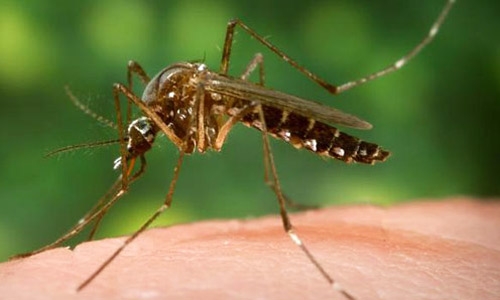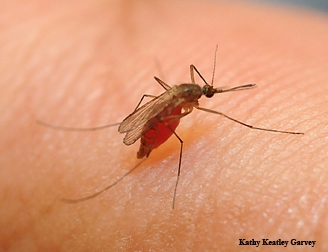
Native Brazilian Walter Leal, chemical ecologist and professor in the UC Davis Department of Molecular and Cellular Biology, is there.
So is the mosquito.
At the symposium today, Constancia Ayres, research coordinator of the Oswaldo Cruz Foundation (Centro de Pesquisa Aggeu Magalhaes/FIOCRUZ, considered one of the oldest and most prestigious scientific research institutes in South America), reported that the common southern house mosquito, Culex quinquefasciatus, may be a potential vector of the Zika virus.
Studies in the Ayres lab confirmed that Culex quinquefasciatus infected with Zika (isolated from local patients) showed high transmission rate (as determined by virus replication in the salivary glands).

Of course, these studies were done in the lab, not the field, and this is the beginning of the research.
We asked medical entomologist William Reisen, editor of the Journal of Medical Entomology, and professor emeritus, Department of Pathology, Microbiology and Immunology, UC Davis School of Veterinary Medicine, about this.
"In California less than 3 percent of the Culex including Cx. quinquefasciatus have been found to feed on humans, even in cities like Los Angeles, where humans are the most numerous host," Reisen said in an email. "Therefore, even if they are susceptible to infection, the probability of a female feeding on humans to acquire and then refeed on humans to transmit would be 0.03 x 0.03 = 0.0009 or a rare event indeed. That said, there are areas of the world where quinquefasciatus feeds predominantly on humans in domestic settings. (See his research paper, Host Selection Patterns of Some Pakistan Mosquitoes (U.S. National Library of Medicine, National Institutes of Health).
In his research paper on Pakistan mosquitoes, Reisen mentions Culex pipiens fatigans, now known as Culex quinquefasciatus. Its feeding patterns "varied opportunistically with host availability," he wrote in the abstract. Resting in cattle sheds during the winter, it "fed on birds and bovids, changing to man and bovids during the spring and then to man and birds during summer."
Medical entomologist Thomas Scott, distinguished professor of entomology (now emeritus) of the UC Davis Department of Entomology and Nematology, is a global authority on Aedes aegypti, which transmits dengue, yellow fever, chikungunya and the Zika viruses.
"Vector competence studies in the lab is valuable information, but before we come to the conclusion that Culex quinquefasciatus is an important contributor to transmission of Zika virus, the lab results would need to be confirmed," Scott told us. "Other laboratories and appropriate field studies would need to be carried out in areas where Zika virus is being transmitted to confirm that this species is naturally infected and is regularly biting people. Although it is a potentially important discovery that would change they way we think about Zika virus transmission, it would be wise to carefully explore all of the details necessary to incriminate a mosquito vector before coming to a strong conclusion."
UC Davis medical entomologist Anthony Cornel of the Kearney Agricultural Research and Extension Center and UC Davis Department of Entomology and Nematology, weighed in: "I have to examine the vector competence data carefully to determine its infectivity dose relative to Aedes aegypti. If Culex quinquefasciatus does play an additional role in transmission then it would be of even greater concern because the threat of autochthonous transmission will occur in areas other than where Aedes aegypti is found in California. Culex quinquefasciatus also feed on people but do so at dusk and at night."
"Brazil could be facing a greater fight against the zika virus than previously feared as researchers investigate whether the common mosquito is transmitting the disease," Moraes wrote in the article, headlined "Brazilian Experts Investigate if 'Common Mosquito' is Transmitting Zika Virus."
"The Aedes aegypti species of mosquito was thought to be solely responsible for spreading the virus," Moraes pointed out. "But scientists are now studying whether the Culex mosquito--the variety (species) most commonly found in Brazil--could also be passing on the infection."
Constancia Ayres was quoted as saying: "This may be the reason for the virus replicating faster. The interaction of the mosquito with the virus may explain the epidemiological profile of disease transmission.”
Meanwhile, the headlines continue as research proceeds.
The Outbreak News Today related that researchers in the Ayres lab "are now investigating the possibility that other, non-Aedes mosquito species, might carry and spread Zika and Chikungunya."
"The concern is that the Culex mosquito--which is 20 times more prevalent than the Aedes variety in Brazil-- might also play some role in the rapid spread of these viruses," Outbreak News Today noted. "Researchers hope to have some answers in a few weeks,"
Valor.com.br is hot on the story as well. Reporter Marina Hawk emphasized that the work was done in the lab, but field collection is underway.
Attached Images:
